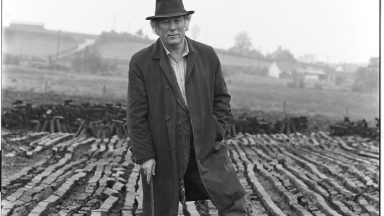Heaney saw the bog as a metaphor for creative potential. In ‘Digging’, the opening poem in his first collection, Heaney proudly wrote:
"My grandfather cut more turf in a day than any other man on Toner’s bog."
His grandfather digging is a metaphor for the poet digging for inspiration. Instead of a spade, his tool of choice is a pen, and he proclaims,
But I’ve no spade to follow men like them.
Between my finger and my thumb
The squat pen rests.
I’ll dig with it.
Heaney also saw the bog as a symbol of Irish identity, not only because it is a main feature of the country’s landscape, but because the wet, earthy peat of the bog is an environment that preserves and remembers everything.
In ‘Bogland’ the closing poem of his second collection, Heaney celebrates the bog as a unique and precious resource. He affectionately refers to it as ‘kind black butter’, and a dynamic landscape that ‘keeps crusting / Between the sights of the sun’. He also saw the bog as a time capsule that preserves our past:
They’ve taken the skeleton
Of the great Irish Elk
Out of the peat.
The bog would take on more significance in his writing in his subsequent collections.
In 1969, he read a book called ‘The Bog People’ by a Danish archaeologist named P.V. Glob. This book was about Iron Age bodies that were found buried in bogs around Northern Europe. Heaney read that these people may have been killed as a sacrifice to a land god to ensure the renewal and fertility of the territory in the spring. In an essay titled ‘Feeling into Words’ he described the book’s impact on him saying:
"the unforgettable photographs of these victims blended in my mind with photographs of atrocities, past and present, in the long rites of Irish political and religious struggles."
He would use bog bodies as a powerful metaphor to talk about the political violence in Northern Ireland. It inspired him to write a series of bog poems that mainly feature in his collection, North. In 1976, Heaney went to Denmark to meet P.V. Glob and see the bog bodies that had inspired him.
Increasingly aware of the long-term effects of turf cutting and industrialisation, Heaney used his writing to protect bogs and wetlands. In May 1989, Heaney donated a manuscript draft of a bog poem titled ‘Belderg’ (a poem about the Céide Fields found buried beneath the bog) to an auction for the Irish Peatland Conservation Council. Then in 2005, when the unspoilt boglands and wetlands near Lough Neagh were threatened by a new motorway, Seamus Heaney was one of the many voices who spoke out in protest. He wrote a letter to the Secretary of State for Northern Ireland Peter Hain, saying that he had been ‘alerted to the damage that will be done to the ecology in the Lough Beg/Creagh Bog area’. He stressed the importance of the area to him by writing:
"I have known and loved this area since childhood and have written about it – or rather out of it – often."
To learn more about Heaney’s connection to the bog, visit our exhibition Seamus Heaney: Listen Now Again where you can explore drafts of Heaney’s famous bog poems as well as a postcard he sent to a friend while in Denmark.


